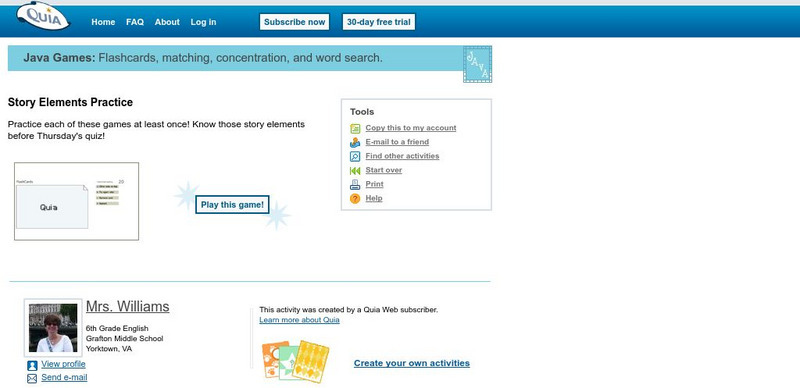E Reading Worksheets
E Reading Worksheets: Main Idea Worksheets
In this learning module, students will learn how to identify the main ideas in individual pararaphs. Worksheets, PowerPoint lessons, and activities are provided to reinforce the concept of main idea. This module is designed to support...
ReadWriteThink
Read Write Think: Plot Structure: A Literary Elements Mini Lesson
Contains plans for two lessons that ask young scholars to apply Freytag's Pyramid (also known as Freytag's Triangle) to pieces of writing, oral storytelling, and television shows. In addition to objectives and standards, this...
Quizlet
Quizlet: R.3 Analyze How and Why Individuals, Events, or Ideas, Develop/interact
Please align to CCSS.ELA-Literacy.CCRA.R.3 Analyze how and why individuals, events, and ideas develop and interact over the course of a text.
E Reading Worksheets
E Reading Worksheets: Text Structure Activities
Numerous links related to analyzing text structures are provided on this site. Lesson plans, PowerPoint slides, graphic organizers, rubrics, and quizzes related to text structures are also provided to support students while analyzing...
Other
Thoughtful Learning: ccss.ela literacy.w.7.3.a
Pick and choose from these lessons and units that focus on narrative writing. Specifically, how to establish a context and point of view, introduce characters, and organize an event sequence.
Learning Farm
Learning Farm: Common Core Standards: Text Structure in Literature
Practice comparing and contrasting the structure of two or more texts and analyze how the differing structure of each text contributes to its meaning and style. Choose test mode or game mode!
CommonLit
Common Lit: Themes
This is a collection of Grade-Leveled texts (3-12) based on your choice of 26 different themes such as America, Beauty and Happiness, Community, Death, War, etc. [Free account registration required for specific tools.]
Reading Rockets
Reading Rockets: Teach Expository Text Structure to Facilitate Comprehension
Expository text can be challenging to young readers because of the unfamiliar concepts and vocabulary it presents. Discover ways to help your students analyze expository text structures and pull apart the text to uncover the main idea...
AdLit
Ad lit.org: Classroom Strategies: Story Maps
Story Maps are used for teaching students to work with story structure for better comprehension. This technique uses visual representations to help students organize important elements of a story. Students learn to summarize the main...
AdLit
Ad lit.org: Previewing Texts in Content Classrooms
Textbook previewing strategies focus not only on the structure of the text - such as the table of contents, index, chapter introductions, and so forth - but on a content overview, which focuses on the concepts and questions covered in...
Ted Nellen
Cyber English (By Ted Nellen): Theme
This is a glossary entry for the term "Theme" including a definition and an example.
ACT360 Media
Writing Den
The WritingDEN includes feature articles with associated words, sentences, and paragraphs to aid in the writing process. Interactive features include pronunciation guides and content quizzes. The Tips-o-matic section offers grammar...
Quia
Quia: Rags to Riches: Literary Elements: Setting, Plot, and Characters
In this game, students answer questions about the story elements of setting, plot, and characters
Curated OER
Mc Graw Hill: Reading Literature: Determine Theme/central Idea
A definition of theme or central idea along with a link to a practice activity. CCSS.ELA-Literacy.CCRA.R.2
Curated OER
Ccss Literacy E Handbook: Literature: Summarize
An explanation of summarizing a selection along with a link to a model summarizing activity.
Curated OER
Mac Millan: Story Elements: Grade 6
This learning module focuses on analyzing story elements including the order of events, character, conflict, resolution, and plot. It provides a model story with questions and answers and then a practice story with questions.
Other
Anthologies online.com: Understanding Theme and Premise
AnthologiesOnline.com provides this article Understanding Theme and Premise by Susan J. Letham, which provides tips on how to develop ideas for writing.
Quia
Quia: Narrative Structure Elements
This reading resource provides vocabulary words with definitions. All words are related to the elements of narratives. A link to associated review activities is included.
University of Victoria (Canada)
The U Vic Writer's Guide: Literary Term: Theme
This site provides a general description of theme, complete with a couple of examples.
Houghton Mifflin Harcourt
Holt, Rinehart and Winston: Elements of Literature: Imagery Chart [Pdf]
A short graphic organizer for students in studying the literary element of imagery. Includes a definition and chart with five sections with examples, one for each of the senses.
Quia
Quia: Story Elements Practice
This series of flashcards from Quia helps students perform a quick check of their understanding of student elements, such as setting and conflict.
Houghton Mifflin Harcourt
Holt, Rinehart and Winston: Theme: The Story's Meaning and Roots [Pdf]
A PDF worksheet that provides five important questions to help you analyze theme. RL.9-10.2 and 11-12 Analyzing Theme.
ReadWriteThink
Read Write Think: Lesson Plan: Audience, Purpose, Language in Electronic Messages
Lesson plan considers changes in writing style since the inception of e-mail and text messaging.
Sophia Learning
Sophia: Setting and Theme
This slideshow lesson defines setting and theme, explains the relationship between them and offers strategies to find the theme in fiction writing.



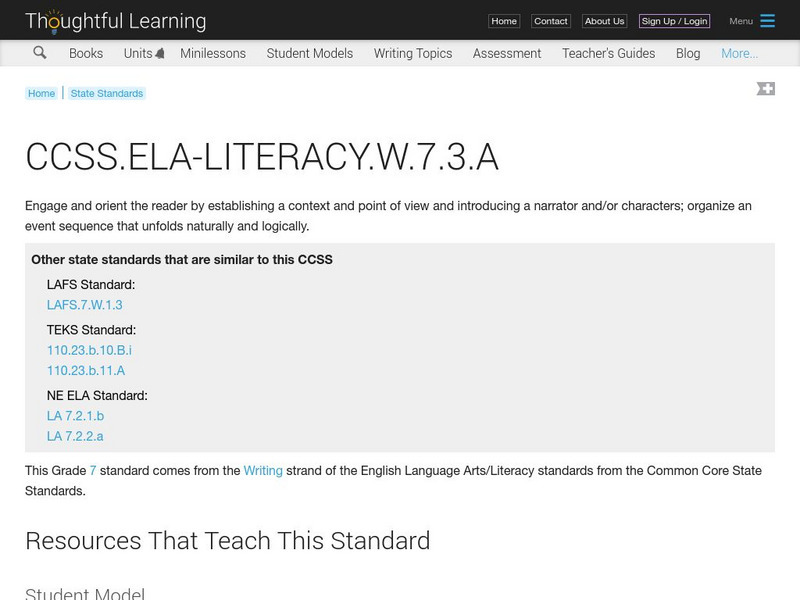


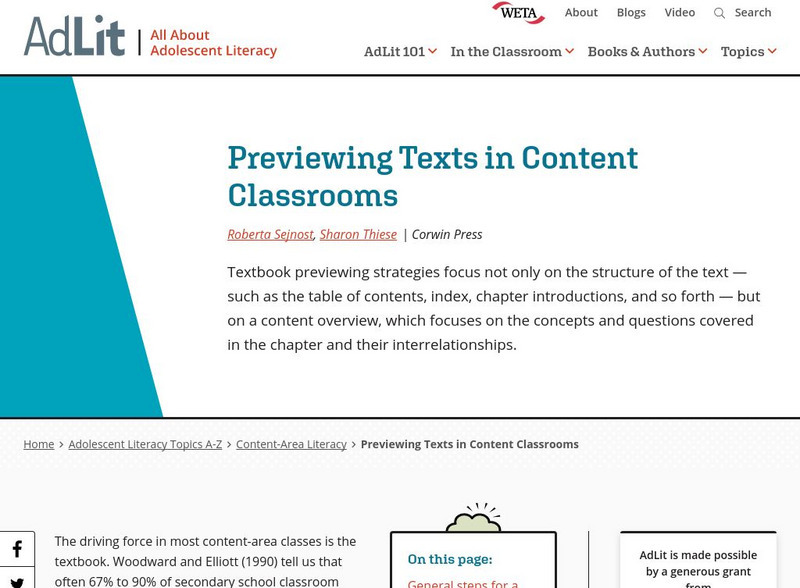
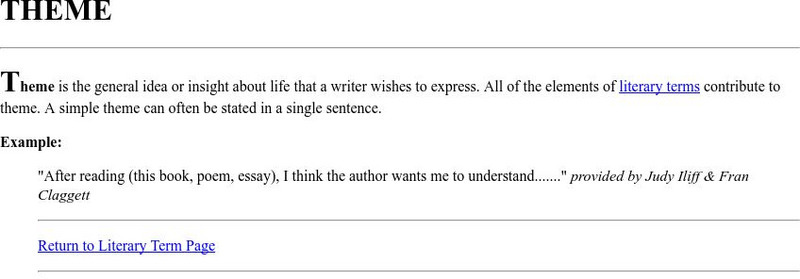
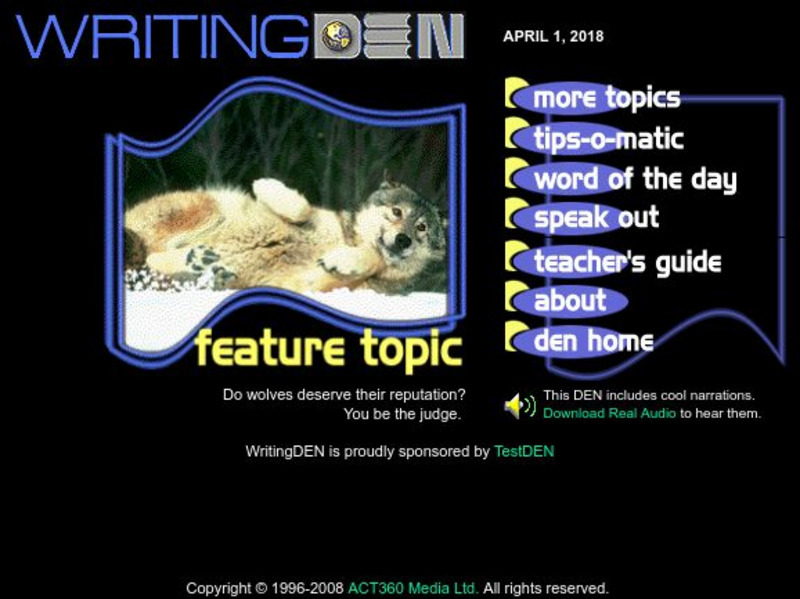

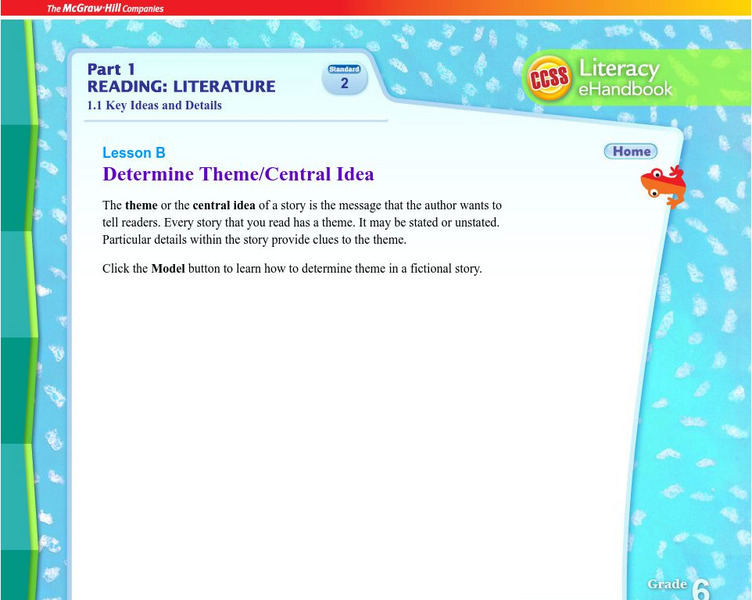

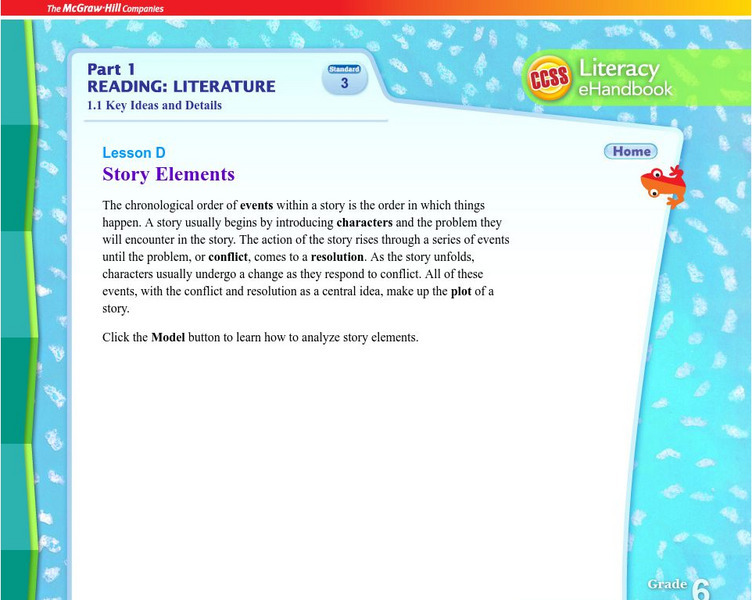



![Holt, Rinehart and Winston: Elements of Literature: Imagery Chart [Pdf] Graphic Holt, Rinehart and Winston: Elements of Literature: Imagery Chart [Pdf] Graphic](http://content.lessonplanet.com/resources/thumbnails/410053/large/bwluav9tywdpy2symdiwmduymc03nzuwlw5iazfsby5qcgc.jpg?1589985125)
